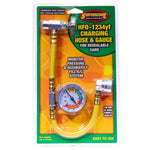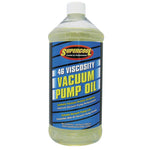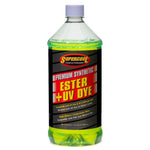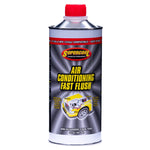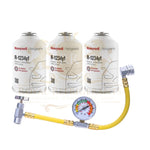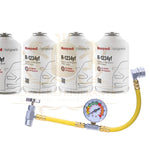You have no items in your shopping cart.
Everything You Need to Know About GAS FREON 134A for HVAC and Automotive Applications
Refrigerants are the heart of every cooling system, and among the most widely used in the world is Gas Freon 134A (R134a). Known for its strong cooling performance, reliability, and versatility, R134a has been the industry standard for decades in both HVAC systems and automotive air conditioning. Despite the introduction of new low-GWP refrigerants, R134a remains a popular choice due to its proven efficiency, availability, and compatibility with existing equipment.
In this guide, we’ll cover everything you need to know about Gas Freon 134A, including how it works, its key benefits, applications, environmental considerations, pricing, and why it continues to play a major role in the refrigeration and automotive industries.
What Is Gas Freon 134A?
Gas Freon 134A, also known as R134a or 1,1,1,2-Tetrafluoroethane, is a hydrofluorocarbon (HFC) refrigerant that replaced older chlorofluorocarbons (CFCs) like R12. It was introduced in the early 1990s as a more environmentally friendly option and quickly became the global standard for automotive air conditioning and many commercial HVAC systems.
Key specifications of R134a:
- Chemical formula: C₂H₂F₄
- ASHRAE classification: A1 (non-flammable, low toxicity)
- Boiling point: -26.3°C (-15.34°F)
- Global Warming Potential (GWP): ~1300
- Ozone Depletion Potential (ODP): 0
Because R134a does not deplete the ozone layer and is highly efficient, it has been used in millions of vehicles and countless HVAC systems worldwide.

Key Benefits of Freon 134A Refrigerant
Here’s why R134a continues to be a top choice for many cooling applications:
Excellent Cooling Performance:
R134a delivers reliable cooling and stable pressure-temperature performance, making it ideal for both automotive and HVAC use.
Widespread Compatibility:
It is compatible with a wide range of compressors, lubricants, and system materials, especially those originally designed for R12 or older systems.
Proven Track Record:
With over 30 years of use, R134a is one of the most trusted and well-understood refrigerants in the market.
Non-Ozone Depleting:
Unlike older CFCs and HCFCs, R134a has zero ozone depletion potential (ODP = 0).
Easy to Handle:
Classified as A1 by ASHRAE, it is non-toxic and non-flammable, making it safe for technicians and end users.
Automotive Applications of Gas Freon 134A
The largest and most well-known application of R134a is in automotive air conditioning systems. It has been the global standard refrigerant in vehicles since the mid-1990s and is still used in millions of cars today.
Benefits of using R134a in automotive systems:
- ✅ Rapid and efficient cabin cooling
- ✅ Easy servicing and widespread availability
- ✅ Proven compatibility with vehicle A/C components
- ✅ Cost-effective for repair and recharge services
Typical automotive uses:
- Passenger car and truck air conditioners
- Heavy-duty vehicle and bus A/C systems
- Electric vehicle battery cooling systems
Even as newer refrigerants like R1234yf emerge, many vehicles on the road still rely on R134a, making it essential for the aftermarket and service industry.
HVAC and Commercial Applications
Beyond automotive use, Gas Freon 134A is widely used in residential, commercial, and industrial HVAC systems. Its stable thermodynamic properties make it ideal for:
- Medium-temperature refrigeration systems
- Commercial chillers and rooftop units
- Dehumidifiers and heat pumps
- Industrial cooling and process chillers
In these systems, R134a offers long service life, consistent performance, and strong efficiency, especially in climates that demand reliable cooling.
Environmental Impact and Regulations
While R134a is ozone-friendly, its global warming potential (~1300) is relatively high compared to new-generation refrigerants like R1234yf (GWP < 1). Because of this, many countries are gradually phasing it down under agreements like the Kigali Amendment and EU F-Gas Regulation.
What this means for you:
- 🌍 R134a is still widely available and legal in most markets.
- 🧰 Existing systems using R134a can continue operating without issue.
- 🔄 Future systems may use lower-GWP alternatives, but retrofits are possible in some cases.
Despite these regulatory changes, R134a remains a crucial refrigerant for existing HVAC and automotive systems, and demand in the service market remains strong.
Pricing and Availability of Gas Freon 134A
One of the major advantages of R134a is its affordability and easy availability. Because it is mass-produced and widely distributed, it remains cost-effective for both consumers and businesses.
Typical price ranges:
- 12 oz automotive cans: $8 – $15 each
- 30 lb cylinders: $130 – $250
- Bulk supply for HVAC: Varies based on supplier and volume
Prices can fluctuate depending on region, supplier, and regulatory changes, so it’s wise to buy from authorized distributors to ensure product quality and compliance.
Safety and Handling Guidelines
R134a is classified as A1 (non-flammable, low toxicity), but proper handling is still essential:
- Always store cylinders in a cool, dry place.
- Use protective gloves and goggles when charging or recovering refrigerant.
- Never vent refrigerant into the atmosphere — always use proper recovery equipment.
- Follow local environmental regulations for refrigerant disposal.
By following these best practices, you ensure safe use, regulatory compliance, and maximum system performance.
Future Outlook: Transitioning Beyond R134a
While R134a will continue to be used for years to come, the industry is gradually transitioning to low-GWP refrigerants like R1234yf and R513A. These alternatives offer similar performance with dramatically lower environmental impact.
However, due to the massive installed base of R134a systems, demand for this refrigerant will remain strong in the aftermarket and service sectors well into the 2030s.
Final Thoughts
Gas Freon 134A (R134a) remains one of the most important refrigerants in the HVAC and automotive industries. Its proven performance, safety, and widespread compatibility make it a reliable choice for cooling systems around the world. Whether you’re maintaining an automotive A/C unit, servicing a commercial chiller, or stocking refrigerant for resale, R134a continues to offer excellent performance and great value.
For businesses and technicians, understanding how to source, handle, and apply R134a effectively ensures continued success in a market that’s evolving toward more sustainable solutions.
 English
English

